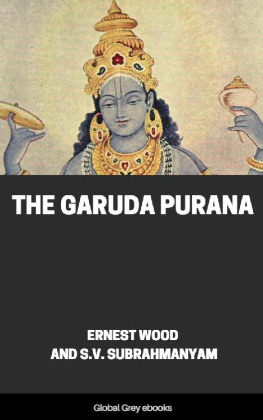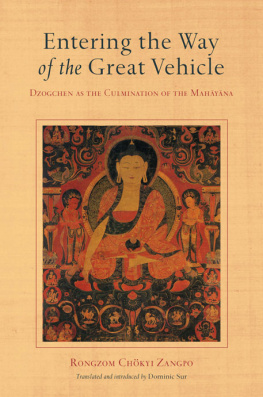
THE FLIGHT OF THE GARUDA

A S THE MYSTICAL TEACHINGS OF DZOGCHEN are becoming more widely taught in the West, those who wish to gain further insight into these clear and powerful practices will find The Flight of the Garuda to be essential.
The book conveys the heart advice of one of the most beloved masters of Tibet. The itinerant yogi Shabkar communicates the essence of the Dzogchen teachings through songs both poetic and poignant.
Along with Shabkars songs, Keith Dowman has translated four other seminal Dzogchen texts, including one by Patrul Rinpoche that is new to this edition.
Dzogchen practice brings us into direct communion with the most subtle nature of experience, the unity of samsara and nirvana as experienced within our own consciousness, bringing the meditator face to face with the nature of reality. Buddhists of all stripes, including practitioners of Zen and Vipassana, will find ample sustenance in these lyrical explications of the Dzogchen view.
THIS SOARING TRANSLATION of Shabkar Rinpoches venerated Dzogchen teachings is in good hands with Keith Dowman. I heartily recommend it to students of this path and to anyone interested in Buddhist songs and spiritual enlightenment. Lama Surya Das, author of Awakening the Buddha Within
A WONDERFUL AND USEFUL BOOK, extremely helpful in my Dzogchen studies.
Ram Dass, author of Be Here Now
KEITH DOWMAN has received lay ordination in the Nyingma school of Tibetan Buddhism and is the author of more than a dozen books on Tibet and Tibetan Buddhism, including Natural Perfection and Original Perfection.
Wisdom Publications
199 Elm Street
Somerville, MA 02144 USA
wisdompubs.org
2003, 2014 Keith Dowman
All rights reserved.
First edition published 1994
Library of Congress Cataloging-in-Publication Data
The flight of the Garuda : the Dzogchen tradition of Tibetan Buddhism / compiled and translated by Keith Dowman.Rev. ed.
p. cm.
Includes bibliographical references.
1. Rdzogs-chen (Ri-ma-pa) I. Dowman, Keith.
BQ7662.4.F55 2003
294.3420423dc21
2003004897
ISBN 978-0-86171-367-7 ebook ISBN 978-0-86171-853-5
19 18 17 16 15
8 7 6 5 4
Cover painting by Terris Temple.
Photography by Lorene Warwick, courtesy of Steve Johnson, with thanks to Venerable Carol Corradi.
Interior and cover designed by Gopa&Ted2, Inc.
For Jason and his generation:
May all manner of things be well.
CONTENTS

A revealed text by Guru Chowang
by Shabkar Lama Jatang Tsogdrug Rangdrol
A revealed text by Rigdzin Godemchen
by Padmasambhava
by Patrul Rinpoche
by Patrul Rinpoche
Table of Contents
Guide
PREFACE

I N THE FIRST YEARS since the work that comprises The Flight of the Garuda was done, a wealth of Dzogchen texts has been translated and published. This has provided insight into both the breadth and depth of Dzogchen. This revised edition takes those new insights into consideration but contains only minimal corrections to the original translations so that the integrity of those translations could be maintained.
To the four basic texts I have added a translation of Patrul Rinpoches Extraordinary Reality of Sovereign Wisdom. If it is possible that a Dzogchen meditation manual exists then this is it. Shabkar Lamas Flight of the Garuda includes some precepts and meditation instruction on Dzogchen preliminaries, and indeed Dzogchen meditation itself. But Extraordinary Reality provides a complete practice including instruction on view, meditation, and action. Simply reading the text may induce the state of nonmeditation that is then to be sustained in the meditation session. In this way it is an initiatory text and, as Patrul Rinpoche asserts, identical to the mind of Garab Dorje himself. Since my first translation of this text was published in 1982 several excellent versions have become available. The improvement of this very important translation over the years is indicative of the increase of our understanding and expression of Dzogchen. My thanks to all who have made it possible.
Keith Dowman
Surendra Bhawan
Kathmandu
TECHNICAL NOTE

I HAVE ADOPTED the following conventions in an attempt to make the text as accessible as possible. I have used Tibetan or Sanskrit words in the text only when I have been unable to find an English equivalent. Tibetan words appear in italicized, phonetic form in the text, with their transliterated form in the index. In the notes and occasionally in the text Tibetan words are transliterated according to the Wylie system. Many technical Sanskrit terms have now been assimilated into English (yoga, samadhi, nirvana, mandala, etc.); those that have not appear in italics with appropriate diacritical marks. Whenever the Sanskrit equivalent of a Tibetan word may be of use, primarily in the footnotes and glossaries, I have included it after the transliterated Tibetan word.
PREFACE TO THE FIRST EDITION

T HIS BOOK CONTAINS the English translation of four Dzogchen texts belonging to the Nyingma school of Tibetan Buddhism. Dzogchen, the Great Perfection, is the quintessence of the tantric paths to buddhahood.
Among these texts, Secret Instruction in a Garland of Vision is one of three texts said to have been written by Padmasambhava, Tibets great guru, who visited Tibet in the eighth century. It belongs to the lamrim genre, a stage-by-stage description of the path to buddhahood. The Flight of the Garuda, written by Shabkar Lama in the nineteenth century, comprises a series of twenty-three songs composed to inspire and instruct the yogin practicing Dzogchen tregcho meditation. The two shorter versified works are extracts from liturgical revealed texts. Emptying the Depths of Hell, revealed by Guru Chowang in the thirteenth century, provides a Dzogchen confessional liturgy, and The Wish-Granting Prayer of Kuntu Zangpo, revealed by Rigdzin Godemchen in the fourteenth century as part of an extensive Dzogchen tantra, is a prayer for attainment of the Dzogchen goal.
In the introduction to the book I have attempted to place Dzogchen in a nondogmatic, less abstract, and more human context, by providing a subjective explication of it. Necessarily, Western notions and personal proclivities, needs, and biases have slipped into this interpretation. Insofar as my understanding is imperfect, the result is partial and unorthodox. However, the reader may benefit from this personal commentary if, through inspiration derived from the translations, he fills the gaps, bridges the contradictions, and jumps beyond the verbal inadequacies to a Dzogchen view. But no text or commentary is a substitute for transmission from an exemplar of Dzogchen attainment who demonstrates the Dzogchen path spontaneously and directly.
Next page













